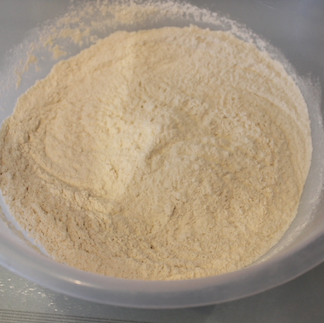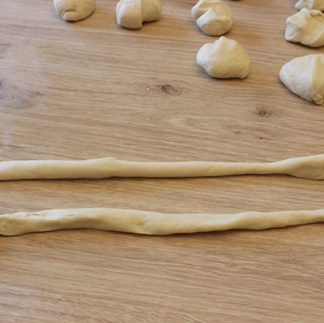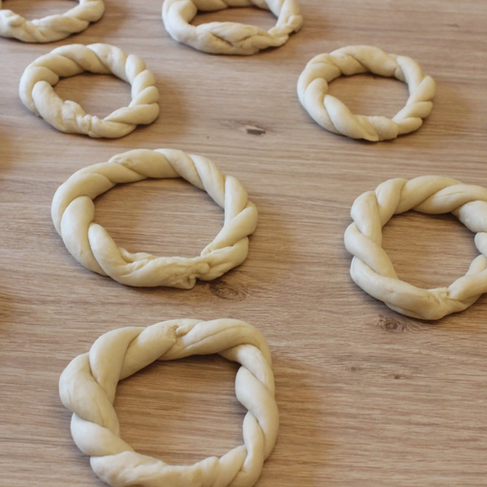Turkish Simit Bread
- Sibel
- Apr 19, 2022
- 6 min read
Updated: Jun 17, 2022
Simit breads are one of the most popular street foods in Turkey. These circular shaped breads are coated with molasses and covered with toasted sesame seeds, making them golden and crispy outside, and soft and fluffy inside. These delicious breads are perfect served for breakfast with some olives, vegan white cheese and Turkish tea, or they make a lovely savoury snack.

It’s been almost a week since I returned from my trip to Istanbul and it’s safe to say I miss it already. If you've ever visited Turkey, you’ll be familiar with Turkish Simit bread, and you’ve probably seen them being sold in the streets in small carts or street vendors. During my time In Istanbul, I’d sampled almost every kind of Simit there is, so I know a good Simit when I taste one. For me, a Simit isn’t just a piece of bread, it’s something that brings back some of my fondest memories of walking along Karaköy and picking up a Simit from the street vendor to snack on as I strolled along the charming streets, or enjoying a fresh Simit on the ferry while on my way to Üsküdar , Simit in one hand, a Turkish tea in the other, the fresh sea breeze and the mesmerizing view of Istanbul from a distance. Isn’t it amazing how the smell and taste of a certain food can bring memories rushing back to you? I wanted to bring a taste of Istanbul to my home in London, so I made several attempts at perfecting my recipe and I can say they taste just as nice as the ones I had in Istanbul. If you love baking and eating bread as much as I do, you're going to love this recipe!

How Does Simit Taste?
Simply put, it’s delicious! Imagine the crustiest bread you’ve ever eaten, with a slight sweetness and nuttiness on the outside from the molasses and toasted sesame seeds, and inside it’s soft and fluffy – what’s not to love about that?! The good news is, if you’d like to sample a simit before investing a few hours of your time into making them, there is a Turkish chain of bakeries called ‘Simit Sarayi’, and they have branches across 22 countries, so you can check to see if there is a branch near you, and if there is, you can pop in to try a Simit. I’ve been to several Simit Sarayi bakeries in London, New York and Istanbul, and the Simits I tried were decent, but nothing beats a freshly baked homemade Simit!

How is Turkish Simit Different from Bagels
I’d say that the only similarity between a Simit and the bagel is the circular shape, aside from that, they have a completely different taste and texture. Instead of being boiled like a bagel, the Simit dough is twisted into a circular shape, and coated in molasses and toasted sesame seeds before being baked at a high temperature. Bagels tend to be quite dense and they don’t have much crust outside, whereas the texture of simit is soft and fluffy inside and crispy outside.

What to serve with Simit
Simit is traditionally eaten as a snack with a cold glass of Ayran (Turkish yogurt drink), or its served for breakfast with a side of olives, sliced tomato, cucumber, Turkish white cheese and a glass of Turkish tea. I like to serve my Simit the traditional way with olives, tomatoes, cucumber and vegan cheese. Simit bread goes well with almost anything, savoury and sweet, so you can enjoy it on its own or serve with anything you desire.

Traditional Simit Ingredients
A classic simit recipe calls for yeast (I used instant dry yeast), strong white bread flour, a bit of salt, sugar, warm water, sunflower oil, toasted sesame seeds and molasses. What makes the Turkish simit extra crispy and irresistible is the molasses it’s coated in before being baked. Not only does the molasses give it a nice golden colour and crispy texture when baked, it also adds a delicious sweetness and helps the sesame seeds to stick onto it better. I’ve used grape molasses for this recipe, but you could also use date molasses, apple molasses or mulberry molasses.

How to Make Simit
I’m not going to sit here and tell you it’s easy, because it isn’t, but what I can tell you is that it’s a really fun and rewarding process. If you have a keen interest in making homemade bread, you’ll enjoy making Simit. I added step by step photos of the process to make it easier to follow along.
STEP 1:
To toast the sesame seeds, place them in a large non-stick pan over a medium heat and toast until they turn golden brown, for about 10 minutes. Make sure to stir occasionally so the sesame seeds don’t burn. Transfer the toasted sesame seeds to a large plate and allow them to cool down.

STEP 2:
Add the warm water, instant dry yeast and sugar into a large measuring jug, give it a whisk and let it sit for about 5 minutes until the yeast starts to bubble up. Add the flour and salt to a large bowl, then pour the oil and water and yeast mixture into the bowl.
STEP 3:
Start by mixing the dough with your hand until it comes together. Lightly dust a clean counter with flour and transfer the dough onto the surface. Knead by hand to form a smooth and elastic dough, for about 10 minutes, or until the dough is not sticking to your hands. Transfer the dough to clean bowl, cover the top with cling film and let it prove for about 30-40 minutes, or until it has doubled in size.
STEP 4:
Divide the dough into two equal parts, then roll each piece of dough into two 51cm (20 inch) long cylinders. Using a knife, cut each cylinder into 10 equal pieces (you should have 20 dough pieces in total), and roll each piece of dough into a ball shape. Cover the dough balls with a damp tea towel to prevent them from drying as you shape the simit. For each Simit, roll out two pieces of dough to create two equal length 41cm (16 inch) cylinders, then twist the dough cylinders in the opposite direction to form a twisted rope.
STEP 5:
Shape the twisted dough into a 5-6-inch diameter ring and pinch to seal the dough together.
STEP 6:
To make the coating, add the molasses, 2 ½ tbsp flour and water to a large bowl and whisk until thoroughly combined.

STEP 7:
Dip the Simit into the molasses mixture (on both sides). Fish the simit out using a slotted spoon to drain away the excess molasses, then drop the simit into the plate with the toasted sesame seeds, making sure that both sides of the simit are fully covered with sesame seeds. Repeat the process with the rest of the dough and transfer each simit onto 2-3 lined baking trays, leaving a small gap between each simit. If you have you small oven, you might have to bake them in two separate batches.
STEP 8:
Place both trays into a 220°C (428°F/ gas mark 7) preheated oven and bake for 15-18 minutes or until golden and crisp. Let them cool down for about 5 minutes and serve while still warm.

Tips for making Simit
I recommend using the gram measurements rather than the cup conversions. When it comes to baking, accuracy is key, and cup conversions are never as accurate as grams.
Make sure to combine the instant dry yeast with warm water. The warmth of the water will enable the yeast to activate.
If you’d like to make smaller sized simits, you can divide the dough into 40 pieces rather than 20 and follow to same process to make 20 mini simit breads.
If you’d like to avoid kneading the dough by hand, you can add all of the dough ingredients to the bowl of a stand mixture, with the dough hook attached, and leave the dough to knead for about 10 minutes.
How to Store Simit
To store leftovers: allow the simit to cool down once it’s baked, then place in a bread bag and store in a cool, dry place. Simit bread should stay fresh for 2-3 days, but it will lose it’s crunchy texture the longer it’s left to sit, so I’d recommend you toast any leftover simit before serving.
To freeze: the good news is, baked simit can be frozen. After the simit breads have baked, let them cool down completely before placing them inside a freezer bag, and storing them in the freezer for up to two months. To thaw the Simit breads, leave them out at room temperature for 20 minutes, then place them in a preheated 220°C oven to bake for about 10 minutes.

































